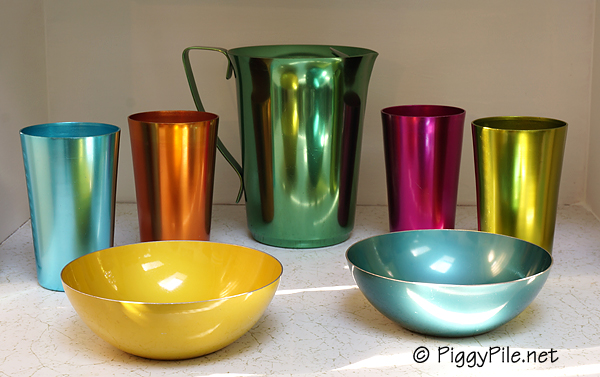Aluminum was invented in 1852 by Henri Deville, a Frenchman, when he used copious amounts of electricity to refine bauxite (a type of clay from Le Baux in southern France). Aluminum used to be more costly than gold. Jewelers pounded it into knives, forks, and spoons for Napoleon III to use at his state dinners.
In 1852, a pound of aluminum cost $545 ($14,170 in today's dollars). By 1890, thanks to a new, simplified refinery process, it cost $2.25 ($58.50 today).
Early aluminum pieces were mostly silver-colored. This assortment of kitchen items includes a small cupcake pan, Jello molds, a butter dish, and a tart pan.
This 9" lamp dates back to the 1940s, at least.
Aluminum is widely used in the transportation industry. The upper floors of passenger liners are constructed of aluminum. Although this engineering feature works good when the ship is upright and operating as should be, it is one of the factors that complicated the recent raising of the Costa Concordia, the cruise ship that ran aground off the coast of Italy and sank in 2012. Aluminum is weak and therefore the flotation ballasts couldn't be attached to it. That left a very narrow corridor around the steel hull to work with.
World War 2 military designers in the aircraft industry made heavy use of aluminum. After the war, the supply was abundant, and decorative arts designers came up with innovative and colorful uses for housewares.
This set of glasses has a curved rim.
Non-vintage sundae bowls, nice to use for pins.
I was so excited to find this pair of mid-century anodized aluminum bowls from Emalox, a Norwegian company.
I'm not done collecting aluminum, that's for sure.










No comments:
Post a Comment
Your comment won't display immediately.